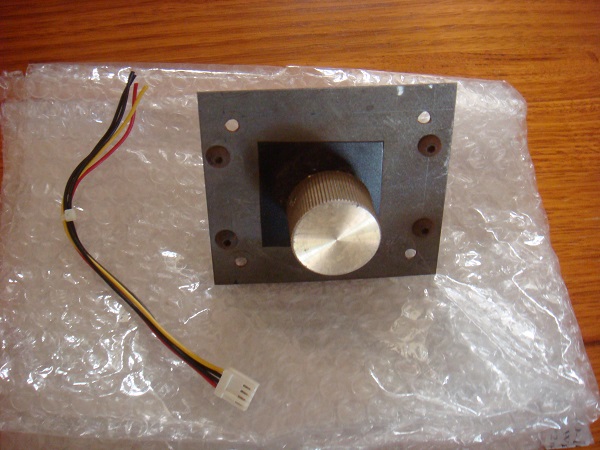

You can buy AS5600s on a breakout board (with a magnet included, but the size of the magnet may be insufficient), so that might save a bit of work, but the breakout boards may be too big to fit my design. AS5600 or AS5601 encoder IC in SOIC-8 (about $4 from DigiKey).

Version 2 uses 3D printed arcade buttons encasing caps. Version 1 used tactile switches with glued on caps for the more rarely used buttons 3 and 4. Also, if you hold down the third button while powering on the device, it switches to Stelladaptor mode, which Atari 2600 emulators should pick up and map as a Driving Controller. I made the bindings to work fairly well with the Internet Arcade emulations on. The resulting device emulates a three-button mouse with the spinner controlling the horizontal motion of the pointer, together with a keyboard mapped from the fourth button and the Nunchuck buttons. The microcontroller scales the 4096 per rotation resolution to 1200, as that seems to be what popular commercial USB spinners are at.įor USB support, I used an stm32f103c8t6 blue pill microcontroller (clones for about $2 and originals for about $3 on Aliexpress) with the libmaple-based Arduino core and my USB Composite library. And, eventually, I added a port where I can plug in a Wii Nunchuck controller for games like Mad Planets that need a joystick in addition to a spinner. I also added four buttons: two nice big arcade buttons and two cheap tactile switches with a cap glued on. The ball-bearing mount for the spinner lets the spinner keep on spinning by itself for many rotations-it feels very satisfying.
#60 IN 1 ARKANOID SPINNER FREE#
This reduced cost (especially since I had free samples of the sensor and magnet from Austria Microsystems in my supplies: thank you!), simplified implementation, and has a nice low profile. The sensor detects the rotation of the magnet, and so we can mount the sensor under the knob, and stick the magnet under the knob, and get no-contact position. Spinner controllers are usually made with an optical rotary sensor (though the Atari Driving Controller uses physical metal contacts), but I went for one using a Hall-effect I2C magnetic absolute rotary sensor, together with a ball-bearing mounted knob with a matching round magnet. Spinner controllers differ from paddle controllers like those for Pong and Breakout (and the NES port of Arkanoid), because a spinner allows unlimited 360 degree rotations, while paddle controllers have a limited range of motion. The Atari 2600's Driving Controller for the Indy 500 game is also a low-resolution example. A number of arcade games used spinner controllers, the most famous being Arkanoid and Tempest.


 0 kommentar(er)
0 kommentar(er)
